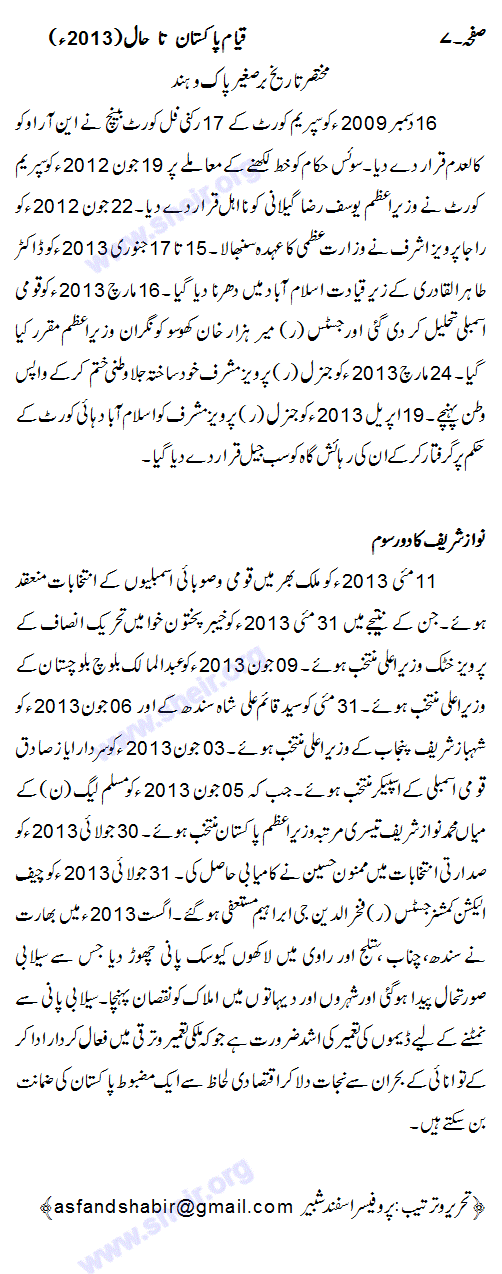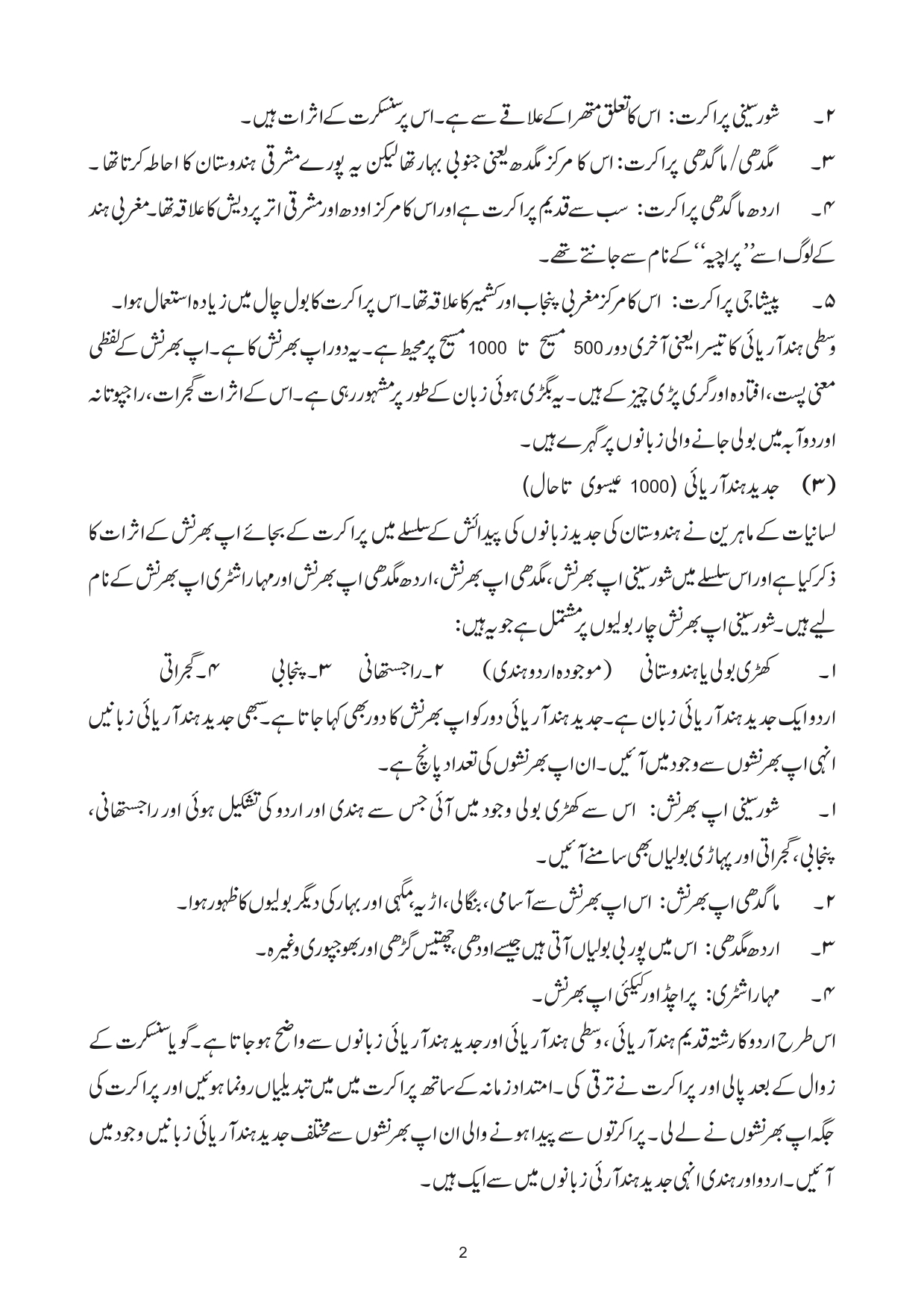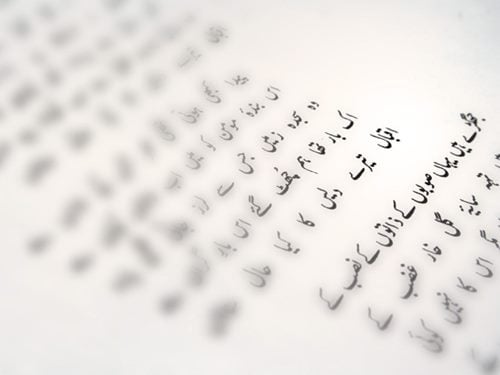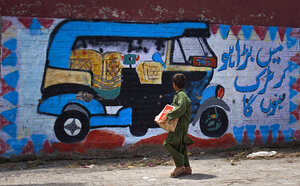Hindi and Urdu are generally considered to be one spoken language with two different literary traditions. That means that Hindi and Urdu speakers who shop in the same markets have no problems understanding each other -- they'd both say yeh kitne kaa hay for 'How much is it? And the Urdu one will be یہ کتنے کا ہے؟ Hindi is written from left to right in the Devanagari script, and is the official language of India, along with English.
Urdu, on the other hand, is written from right to left in the Nastaliq script and is the national language of Pakistan. It's also one of the official languages of the Indian states of Bihar and Jammu & Kashmir. Considered as one, these tongues constitute the second most spoken language in the world, sometimes called Hindustani. In their daily lives, Hindi and Urdu speakers communicate in their 'different' languages without major problems. Both Hindi and Urdu developed from Classical Sanskrit, which appeared in the Indus Valley at about the start of the Common Era.
The first old Hindi poetry was written in the year 769 AD, and by the European Middle Ages it became known as 'Hindvi'. Muslim Turks invaded the Punjab in 1027 and took control of Delhi in 1193. They paved the way for the Islamic Mughal Empire, which ruled northern India from the 16th century until it was defeated by the British Raj in the mid-19th century. It was at this time that the language of this book began to take form, a mixture of Hindvi grammar with Arabic, Persian and Turkish vocabulary. The Muslim speakers of Hindvi began to write in the Arabic script, creating Urdu, while the Hindu population incorporated the new words but continued to write in Devanagari script.
Urdu developed as local Indo-Aryan dialects came under the influence of the Muslim courts that ruled South Asia from the early thirteenth century. The official language of the Delhi Sultanate, the Mughal Empire, and their successor states, as well as the cultured language of poetry and literature, was Persian, while the language of religion was Arabic. Most of the Sultans and nobility in the Sultanate period were Persianized Turks from Central Asia who spoke Turkish as their mother tongue. The Mughals were also from Persianized Central Asia, but spoke Turkish as their first language; however the Mughals later adopted Persian. Persian became the preferred language of the Muslim elite of north India before the Mughals entered the scene.
Babur's mother tongue was Turkish and he wrote exclusively in Turkish. Muzaffar Alam, a noted scholar of Mughal and Indo-Persian history, suggests that Persian became the lingua franca of the empire under Akbar for various political and social factors due to its non-sectarian and fluid nature. The mingling of these languages led to a vernacular that is the ancestor of today's Urdu. Dialects of this vernacular are spoken today in cities and villages throughout Pakistan and northern India.
Cities with a particularly strong tradition of Urdu include Hyderabad, Karachi, Lucknow, and Lahore. Urdu, which was often referred to by the British administrators in India as the Hindustani language, was promoted in colonial India by British policies to counter the previous emphasis on Persian. Urdu replaced Persian as the official language of India in 1837 and was made co-official, along with English. History is replete with events, change, cause and effect on the basis of language.
Political movements and geographical changes occurred in different corners of the world and eras have slightly and massively been linked with language. Many regions are currently facing separatist movements mainly rooted in languages or dialects. It seems simple to differentiate between a language and a dialect. This paper will propose better criteria towards differentiation of language and dialect basing the argument on the empirical evidence of the history of linguistcs.
Standard Urdu has approximately the twentieth largest population of native speakers, among all languages. It is the national language of Pakistan, as well as one of the twenty-three official languages of India. Urdu is often contrasted with Hindi, another standardized form of Hindustani. Linguists nonetheless consider Urdu and Hindi to be two standardized forms of the same language.
While its origins elude precise definition, Urdu clearly began in medieval times from a mixture of the local Indian dialects of the Delhi region with the Persian spoken by the Muslim conquerors whose armies rapidly spread the new lingua franca across the subcontinent. The passion for the creation of Pakistan was triggered by many undeniable realities in the chapter of Hindu Muslim differences. These differences were pervasive and multidimensional, not just confined to religion or culture. Amongst other factors that invigorated the idea of a separate homeland for Muslims of Indo-Pak subcontinent, language was one of the major idea or part of the argument.
This paper explores the contribution of Urdu language in Pakistan movement. It also focuses on how language emerged as a significant factor leading to establish Muslims' linguistic and cultural distinction from Hindus. As Islam was the religious identity of Muslims of subcontinent, Urdu emerged as their lingual identity. Despite multi-lingual diaspora of the Muslim population of India, when Urdu language came to be identified as the lingua franca of the Muslims, struggling for an independent state, they preferred to register Urdu as their mother tongue. Finally, the paper highlights Quaid-e-Azam Muhammad Ali Jinnah's vision and approach toward Urdu language.
The major difference is that of script where urdu is written in persio-arabic script while hindi in devnagari. Both were almost similar languages in oral form 250 years back but now are different from each other due to persianization of urdu n sanskritization of hindi. There are hundreds of millions of tamil,telugu,bengali,punjabi,marathi,etc etc whose languages r entirely different from hindi. I think it would be most accurate to describe Hindi/Urdu as a single language with two separate literary cultures utilizing two distinct scripts.
It would be incorrect to say that 'hindi is from sanskrit and urdu is from arabic/persian,' because both use a grammatical structure that is fundamentally indo-iranian, not semetic . Urdu does emphasize arabo-farsic vocabulary, but hindi includes many, many words from a arabic and farsi. An oft sighted example is the many words we use to express love, e.g., pyaar, prem, ishq, mohabbat etc...of which, only one is derived from sanskrit. I challenge any shud hindi speaker to speak for a day without using any words from arabic and farsi, it is nearly impossible , as even the most common words (e.g. Kitaab) have an arabic root. That being said, written hindi does tend to emphasize sanskit-derived words, as written urdu emphasizes words having an arabic/farsi root.
Urdu is the national language of Pakistan and is spoken and understood throughout the country, where it shares official language status with English. It holds in itself a repository of the cultural, religious and social heritage of the country. Although English is used in most elite circles, and Punjabi has a plurality of native speakers, Urdu is the lingua franca and is expected to prevail. Historically, Hindustani developed in the post-12th century period under the impact of the incoming Afghans and Turks as a linguistic modus vivendi from the sub-regional apabhramshas of north-western India. Its first major folk poet was the great Persian master, Amir Khusrau (1253–1325), who is known to have composed dohas and riddles in the newly-formed speech, then called 'Hindavi'.
Through the medieval time, this mixed speech was variously called by various speech sub-groups as 'Hindavi', 'Zaban-e-Hind', 'Hindi', 'Zaban-e-Dehli', 'Rekhta', 'Gujarii. 'Dakkhani', 'Zaban-e-Urdu-e-Mualla', 'Zaban-e-Urdu', or just 'Urdu'. By the late 11th century, the name 'Hindustani' was in vogue and had become the lingua franca for most of northern India. A sub-dialect called Khari Boli was spoken in and around the Delhi region at the start of the 13th century when the Delhi Sultanate was established. Khari Boli gradually became the prestige dialect of Hindustani (Hindi-Urdu) and became the basis of modern Standard Hindi & Urdu.
During more than two hundred years of British rule, shifting winds of patronage changed the linguistic landscape immensely. It was during the colonial period that the Indian public became more invested in language politics, and began to promote Hindi and Urdu as distinct languages, distinguished not only by orthography, but on a more fundamental level, as markers of cultural identity. Some even engaged in language debates and sought to "purify," standardize, and garner institutional recognition of "their" language.
With independence and Partition in 1947, Hindi became the official language of India, and Urdu the official language of Pakistan, though one of the ironies of this history is that more people claim Urdu as their first language in today's India than in Pakistan. Given the present geopolitical reality in the subcontinent, we may expect to see further consolidation of distinct national standards in the future. Rahman discusses that currently, Urdu is the national language of Pakistan and the identity symbol of Indian Muslims, connected with Islam in South Asia. The British replaced Persian, the official language of Mughal rule, with Urdu at the lower level and English at the higher level.
Urdu becomes the medium of instruction in the Islamic seminaries and the major language of religious writings. It also became part of the Muslim identity and contributed to Islam and mobilized the Muslim community to demand Pakistan which was carved out of British India in 1947. However, Urdu and Islam are symbolic components of the national identity in Pakistan . Here is a surprising fact that the religious ideology of Muslims, which lead to creation of Pakistan, categorically placed ideological identity above all ethnical, racial or linguistic identities. However, the same religious ideology was the basis to promote Urdu language as saviour of Muslims' religious and cultural identity in Indo-Pak subcontinent. It may be called a unique incident in history which needs further exploration and has been left for future research.
URDU, the national language (qaumī zabān) of Pakistan and one of the fifteen officially recognized languages of India. It is spoken, according to recent censuses made in India and Pakistan, by an estimated 53 million people in the South Asian subcontinent (Schmidt, 2004, p. 288). To this we may add the millions of people, both inside and outside the subcontinent, who use Urdu as a primary means of communication.
The Panjabi-speaking population of Pakistan, for example, employ Urdu rather than their own language almost exclusively as a written and literary medium. Along with its "sister language," Hindi, with which it shares a virtually identical grammatical base, Urdu at the most basic, spoken level still functions as a convenient lingua franca, and is intelligible to vast sections of the population of South Asia. For this reason it is the preferred medium of the Indian film industry, to which many well-established Urdu writers contribute scripts and especially songs, the lyrics of which frequently follow the conventions of classical Urdu poetry. He rejects the widely held view that Urdu emerged as a new language when men belonging to disparate linguistic nationalities were recruited into Muslim armies and needed a language to communicate. A pidgin is a reduced language that comes into being from extended contact between groups of people with no common language.
A creole language is an extension of an existing language, which has a core group of native speakers, but becomes considerably simplified as other groups adopt it. He rejects both such descriptions for Urdu, arguing that Urdu has a highly sophisticated structure with distinct grammar and syntax, and that it descends from the Hindu-Muslim cultural synthesis extending over 500 years. During this period, it was used in both the religious and secular literature of Hindus and Muslims.
There were of course the Devanagari and Persian scripts in which this common language was written. The history and origins of any language will have complicated and lateral developments. It is difficult for any language to have a linear and time lined progression. Similarly, the evolution or origin of Urdu has multiple theories surrounding its existence and growth.
However, being itself is an essence of what true integration of cultures might mean. Hindustani was the language whose grammar and syntax was 'Hindi' and whose script was 'Urdu'. It was this language that was spoken, written and expounded by the great minds of its time, including Amir Khusrau. The Hindustani or Hindavi language is what later was referred to as Urdu, but it was laden heavily with vocabulary from both Sanskrit and Persian. Many linguists count both Hindi and Urdu as the same language because of their grammar and vocabulary similarities.
Many others cite it as a socio-political reason for reading and counting them as two separate languages. Hence Urdu emerges perhaps as a wonderful amalgamation of cultures that decided to flourish by taking the best of each other. And in the course, creating a linguistic and literary treasure that finds keepers till date. Urdu, belonging to the Indo-European family of languages, is the official language of Pakistan and one of the 15 officially recognized languages of India. Though it is the mother tongue of about 50 million people, it is spoken and understood by almost the whole population of Pakistan and is the primary means of written communication in that country. Being quite similar to spoken Hindi, it is widely understood in India, and the Indian film industry has given it a great boost.
Urdu boasts an extremely rich literary tradition, which has enriched itself for centuries and continues to do so even in our times. One of those languages was Khari Boli, a language spoken in the north of India from where Hindvi and consequently, Urdu and Hindi languages derived. 2 In this sense, Urdu and Hindi have suffered a process of evolution as well as reforms until its modern and present state. These were mainly due to politico-religious reasons which initiated the split of Urdu and Hindi, although literary movements generated an enormous modifying influence. And Hindi with Muslims and Hindus, respectively, that started in the early 19th century reached its culmination in the first quarter of the 20th century.
The formation of voluntary language associations for these languages and the development of both Muslim and Hindu revivalism strengthened this identification. This congruence of linguistic and religious identities not only increased language conflict between Urdu and Hindi but also led to the expanded use of Hindustani. In the wake of the Indian independence movement, Gandhi saw the potential for the use of Urdu and Hindi to produce political conflict and so promoted Hindustani as a symbol of unity. In 1925, he persuaded the Indian National Congress to accept Hindustani as the official language for its proceedings. Under the influence of Gandhi, many national leaders emphasized the role of Hindustani not only for communal harmony between Muslims and Hindus but also for bringing about national unity. In 1937, Nehru recognized the potential of Hindustani to spread all over the country and declared that it should be officially recognized as an all-India language.
Confusingly, Khariboli is also used to denote the standard form of Hindi-Urdu today, as this regional dialect, once called Dehlavi and centered around the old Mughal capital of Delhi, has had great impact on the official shape of language. South Asia is a now a major economic and geopolitical power, and home to one fifth of the world's population. By conservative estimates, over half a billion people speak the language in South Asia, and depending on chosen parameters, it is variously ranked as the second- to fourth-most widely spoken language in the world!
To directly communicate with this vast population of Hindi-Urdu speakers and have unfettered and unfiltered access to the rich cultural history of North India and Pakistan, fluency in Hindi-Urdu is essential. There a rich literary tradition in Hindi-Urdu, and its dialectal ancestors going back about a thousand years. There is also a thriving popular culture of South Asia, one which is very much dependent on Hindi-Urdu. Soap operas, comic books, Bollywood films, street theater, and love songs, all communicate in this language. Urdu language is an amalgamation of a number of languages including Persian, Arabic, Turkish and Hindi.
Itenjoyed its development in the 14th and 15th century under the Mughal rulers. One might think why during this golden period of Urdu literature, had there been no formal documentation of the language. It borrowed whatever traditions, from its parent languages that are Persian, Turkish and Arabic mainly.
Since there was no method of compiling a history in these parent languages, Urdu too, remained so. Urdu language derived from Sanskrit, an extinct language, into Prakrit and later on into the languages today known as Urdu and Hindi. Elements of Persian, Arabic and Turkish were incorporated into Urdu at a later stage through different language reforms, Islamic and cultural influences. At the same time, Hindi eliminated elements from Persian, Arabic and Turkish and kept on borrowing lexical elements from Sanskrit.
With the arrival of Islam to the Subcontinent, the predecessor language of Urdu and Hindi was split into these two languages according to the religion of the speakers. The Muslims utilized a Persian script called Nastaliq and the Hindus kept de Devanagari script. The split of the language according to the script gave birth, in fact, to two different languages, Hindi and Urdu. This research is conducted under descriptive, analytical and quantitative approaches which mean to place data regarding language development along with an analysis from different angles. In this research, the remaining elements of Sanskrit and Prakrit in Urdu language are studied.






























No comments:
Post a Comment
Note: Only a member of this blog may post a comment.